-
The Kimberley – Voyage Log
Broome to Darwin onboard Coral Adventurer – 14 to 24 May 2021 DAY 1: DEPARTING BROOME 14 May 2021 The day...
Read more -
Tradewind Voyages
THE GOLDEN GIRL Embrace the slow lane on a UK cruise aboard traditional sailing ship 'Golden Horizon' by Rebecca Barnes @ The Jewish...
Read more -
Ocean Medallion
Princess Cruises Innovative Technology Written by Noni Lawson Cruise Express Travel Specialist February 2020 The Ocean Medallion is a...
Read more -
European Cruising Christmas
Christmas will be here again before you know it so now’s the time to plan your next festive escape In that spirit, a ‘part-time’ Christmas...
Read more -
Nature’s Ultimate Playground
The Sub-Antarctic region holds incredibly unchartered abundance and diversity While most of us are very familiar (and some even luckier to have...
Read more
Author: Kathy Fossati
The Kimberley – Voyage Log
Broome to Darwin onboard Coral Adventurer – 14 to 24 May 2021
DAY 1: DEPARTING BROOME
14 May 2021
The day began for many of our guests in Darwin as we had to fulfill quarantine requirements at the airport before boarding the Alliance charter flight QQ775714 for Broome to join up with the rest of the guests at the Broome Civic Centre & our final clearance before catching the Broome Taxi Bus to the Wharf. Once on board the Coral Adventurer we could relax & prepare for our cruise northwards along the little-known Kimberley coastline.
By 3pm we had cleared Roebuck Bay & were on our way up the Dampier Peninsula towards the ‘Kimberley proper’. Crew introductions & safety briefings were soon conducted, allowing us to settle into our new surroundings & enjoy the evening. During the night we could feel the gentle tidal movement as we passed over King Sound & the Fitzroy River mouth & made our way north to an anchorage in Strickland Bay, ready for our first excursion to picturesque Edeline Island.
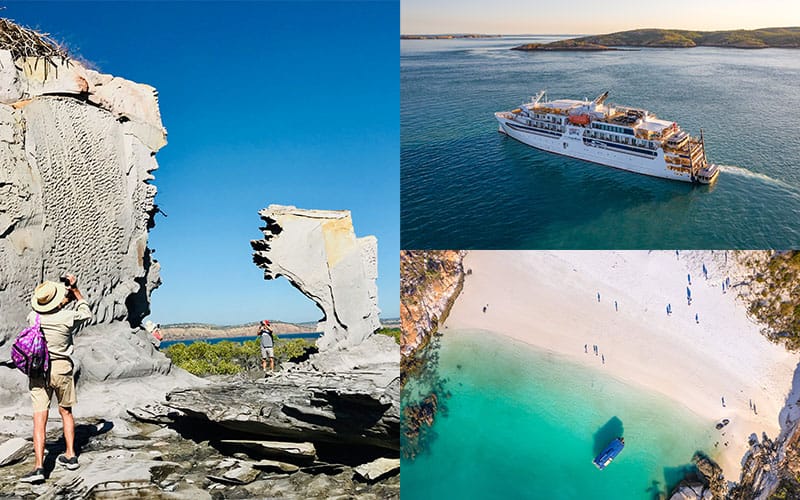
DAY 2: EDELINE ISLAND
15 May 2021
As dawn broke, those ‘early birds’ out on deck saw us cruising into the many islands of the Buccaneer Archipelago, which is where the King Leopold Range disappears into the Indian Ocean like a dinosaur’s backbone. After a good breakfast, we boarded the Explorers from the back of the ‘CA’ & headed into the islands, with all kinds of unusual geological features catching the first rays of the sun. We were now on the southern side of the ‘impact zone’ where, back in historic times, the former island of the Kimberley reconnected with mainland Australia. The last sea-level rise turned this area into over a thousand islands which is now collectively known as the Buccaneer Archipelago.
Today’s target was a little beach on Edeline Island where we could stretch our legs & photograph some old graves of pearl divers from last century, who died in this remote region in the pursuit of highly-prized pearlshell & the occasional pearl. Names like “Fritto Diver” & “Jullo” on the headstones indicate that some of these pearl divers were from places like Timor, to the north of the Kimberley. We were also able to experience ‘up close’ the amazing weathered formations in the Elgee Siltstone structures of Edeline Island itself.
Later in the morning we made our way north into a tidal channel between Chambers & Hidden Islands, where we could see strong currents surging through the narrow valley. Giant Clams & many other components from offshore coral reefs are present here, all of which are fed by the daily, nutrient-rich tidal currents which race through this channel. Beneath the red sandstone cliffs at the eastern end of this ‘Whirlpool Passage’ we witnessed the strength of these currents as the Explorers were pushed around by the eddies & whirlpools generated by the rushing tidal current. The changing geological patterns & colours surrounding us were to become a fascinating aspect of our daily excursions.
Our last stop was a walk in ‘squeaky white sand’ on a secluded beach on the opposite side of Hidden Island, adjacent to Whirlpool Passage. This was Silica Beach, the product of a weathering process of the fine, pale Penticost Sandstones of this northern end of the King Leopold Range. We were able to see Rock Figs Ficus platypoda & rock-dwelling Eucalyps like Eucalyptus brachyandra. We also saw small birds like Striated Pardelotes & Double-bar Finches.
We then sped back to the mother ship in time to enjoy a beautiful sunset during Captain Miles’ complimentary Welcome Aboard sunset drinks up on the Vista Deck – a great first day in our Kimberley adventure.
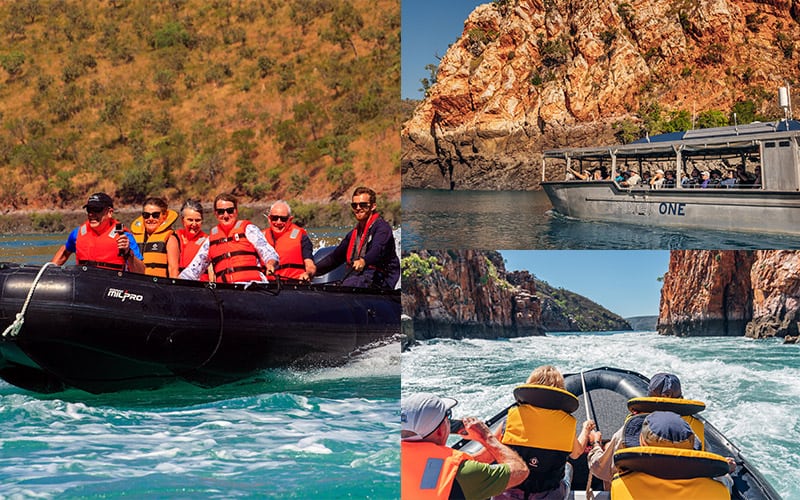
DAY 3: TALBOT BAY & HORIZONTAL FALLS
16 May 2021
Our morning anchorage is in Talbot Bay opposite the gaps in the drowned Leopold Ranges known as the Horizontal Falls. Pearl farmers setting up their industry in the hidden reaches of the Leopold Ranges found a mysterious tidal passage they nicknamed ‘Cyclone Creek’, as it was a safe place to store their floating equipment during the cyclone season. Today, Paspaley Pearls have moved elsewhere & it used as a base for Horizontal Falls Sea Plane Adventures from Broome & Derby.
The recent rise in the sea level (4000 years ago) has drowned the western end of this beautiful 600km long mountain range. Its highest peak is Mt Ord, reaching 937m above sea level. The present landscape of valleys, ridges & deep gorges developed after uplift began 20 million years ago. This morning we cruised through the awesome drowned valleys below towering sandstone ridges, looking for Short-eared Rock Wallabies, Saltwater Crocodiles & Sea-eagles, etc. We saw at close hand the results of the massive pressure applied to these once horizontal sedimentary layers (about 560 million years ago according to the WA govt. geologists) while they were still within the earth’s crust, so that they are now standing almost vertically. We saw the best geological colours & contrasts that nature can produce, reflected double in the mirror-calm waters. The enormity of the whole process defies the imagination. The beauty for us is just to sit in the comfort of the Explorers & enjoy the spectacular scenery in shade & comfort! Mangroves have colonized the shoreline away from the strong currents & we saw some yellow wattle flowers contrasting with the greens of the hillsides. Beds of conglomerate (Pudding Stone) stood out in the otherwise fine sedimentary layering.
It is hard to imagine a more perfect morning to view this region’s imposing geology. What better way to express our deep feelings & gratitude for the King Leopold Ranges than to return to the ‘Calorie Ship’ & eat a hearty lunch!
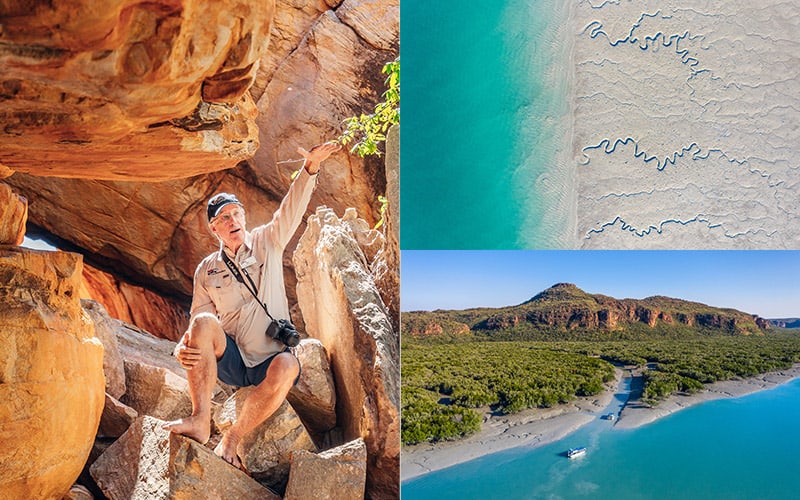
DAY 4: PRINCE FREDERICK HARBOUR & MITCHELL FALLS
17 May 2021
We awoke in our new anchorage at Naturalist Island in Prince Frederick Harbour. Some of our guests were keen to take helicopter flights up on to the Mitchell Plateau to see the northern Kimberley from the air & to walk down to see the Mitchell Falls as the river leaves the plateau & winds its way north to the sea. The choppers collected their passengers from the little beach on Naturalist Island.
Today we are visitors to Wandjina land. The following statement, written from a Worrorra perspective and taken from the Wandjina Tours website, presents an outline of Lalai (traditional rule book) as believed by themselves and associated clan (tribal) groups, the Wunambal and the Ngarinyin:
‘We, along with the Ngarinyin and Wunambal tribes are part of the shared Wandjina culture and belief system. The Wandjina is our supreme spiritual being who created all this country during Lalai (creation/dreamtime). Wallungunder [Walanganda], the Boss Wandjina, came from the Milky Way to create the earth and the people. The first people were the Giyorn Giyorn (Bradshaws figures). They had no laws or kinship and were a lost people. He thought that these people could be good, so he went back up to the Milky Way and asked other Wandjinas with the power of the Dreamtime Snake to help bring laws and kinship to the Gyorn Gyorn people. The Dreamtime Snake represents Mother Earth and is called Ungud. Each of our people have their own Ungud birthplace or dreaming place. The Wandjinas went on to create the animals, and the baby spirits that live in the rock pools or sacred Ungud places throughout the Kimberley, and they continue to control everything that happens on the land, sea and sky today.’
Our morning cruise in the Explorers took us from Naturalist Island up the Hunter River past an unusual stone monolith which Navigator John Lort Stokes called ‘the Ninepin’ & into the mangrove-lined Porosus Creek. Towering sandstone escarpment faces formed a scenic valley sheltered from the strong weather systems of the wet season, allowing extensive tidal forests to develop on vast beds of accumulated sediment. This was home to many forms of wildlife, including Saltwater Crocodiles, which use these sheltered waterways as safe nursery zones for the more vulnerable sub-adults until they reach maturity. We were fortunate to observe some of these juveniles basking on the mudbanks or chasing mullet in the drainage gutters while Brahminy Kites & Sacred Kingfishers patrolled the mudflats for breakfast morsels.
The afternoon activity took us south across Prince Frederick Harbour to one of the many islands known as Lumbarni to the local people. Here we were able to access a couple of the numerous ‘story places’ belonging to the Wandjina tradition, which included a beautiful portrait of a colourful Wandjina personality displayed beneath a low rock overhang behind the beach. Then it was back to our stunning anchorage to enjoy sunset drinks in one of the most remote places on the Australian continent!
Overnight we travelled right around the top of the Kimberley to a completely different landscape.
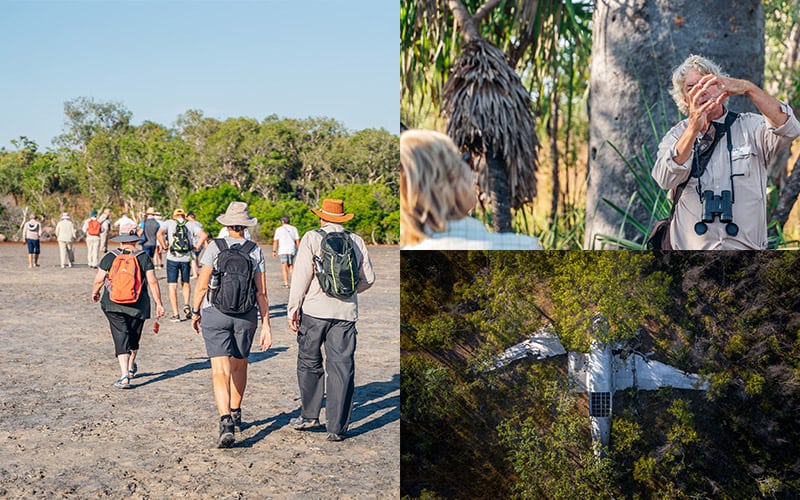
DAY 5: VANSITTART BAY
18 May 2021
As we approached our Vansittart Bay anchorage for the morning’s activities, we could see our new sister-ship ‘Coral Geographer’ at anchor off Jar Island. On arrival on the shore of this small island, made famous by Phillip Parker King back in 1820 when he discovered Makassan clay pottery & other artifacts of the ‘trepang trade’, we were able to exchange greetings with our fellow company members as they departed the site.
We are now on the country of the Wunambal Gaambirra people. They call this place Ngula. As we were about to discover, Jar Island is also decorated with some of the most ancient human history records on the planet. Giyorn Giyorn (Gwion Gwion or Bradshaw) art, is thought to be the cultural product of an ancient race of people with African links who disappeared, along with their language & culture, from the north Kimberley region almost twenty thousand years ago. This is quite different to the bold Wandjina figures from the present-day people, which we saw yesterday on Lumbarni Is. The beautiful & graceful, heavily adorned human figures painted with iron-rich ochres are today just fading stains on the flaking rock surface, but we are so fortunate to be able to access these historic galleries. Of the four primary coloured ochres originally used, only the iron-rich red ochre stains remain to remind us of this long-past civilization.
After a well-earned lunch, the Coral Adventurer was relocated to the eastern side of the bay beside the Anjo Peninsula. Our objective was to land on a beach, walk over some low sand dunes & across a wide tidal flat to some coastal woodland where the wreckage of an American C53 aircraft lays in state from the WW2 era. No lives were lost when the plane from Perth attempted a forced landing on these tidal flats as it ran out of fuel. Large bloodwood trees beside the flats eventually brought it to its final long-term resting position. The crew were later rescued by a Qantas float plane. Ironically, the WW2 Truscott Airbase was constructed on this peninsula just a short time after this mishap only a few kilometers to the north!
After sunset we departed Vansittart Bay for our next anchorage to the east in Koolama Bay.
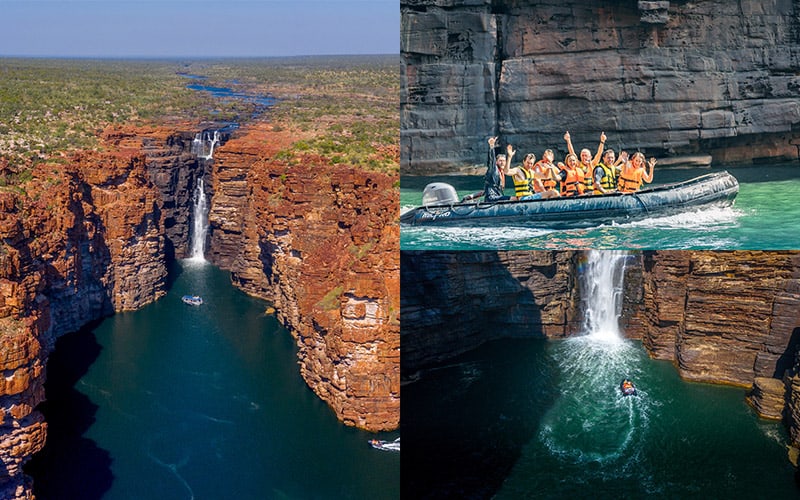
DAY 6: KING GEORGE RIVER
19 May 2021
This morning we found ourselves arriving at anchor in the protection of the sandstone ramparts of Koolama Bay & after a hearty breakfast, we were soon heading up the King George River following a spectacular eroded sandstone valley with towering red sandstone walls, which led many kilometres inland to the famous King George Falls. The Explorers took us into the ancient geological world of the Kimberley. As we motored upstream, we learned the basic facts of this hidden river valley.
This is Kuwini country & is patrolled by the Balangarra Rangers from Kalamburu. The mouth of the King George River eluded detection by the early mariner explorers like Baudin, Freycinet, King and Stokes who had all sailed through Koolama Bay, not noticing the rather insignificant river mouth & it remained to be discovered & given its European name as late as 1911. Charles Price Conigrave was a passionate ornithologist (Rainsbury 2015) and keen to lead a team of four to an overland venture through the then unexplored territory between Cambridge Gulf and Admiralty Gulf. The party crossed this river channel on 7th December 1911 and Conigrave ‘…named the river after King George V whose coronation took place that year….’ (Epton 2003). Conigrave also correctly predicted where the river would discharge into the sea but did not have the time or resources to actually follow this river to what we now know as Koolama Bay, but continued his exploratory journey westward.
The average height of the cliffs here is estimated at 80 meters & the age of the Karundii Plateau at 1,800 million years, which predates life on earth (no fossils). Many of the Warton Sandstone blocks within these cliffs are in ‘precarious’ positions, mainly because of the sea level erosion. The Kimberley region is seismically stable, however distant earthquakes and tremors, common in the Indonesian Banda Sea to the north (the Timor coast is only 525 km away) frequently cause these slopes, and other precariously balanced blocks high on cliff faces to dislodge and fall. Tree root growth within the major joints can also contribute to such falls. We witness new rock-falls after each wet season. Magnificent pastel shades of pink, yellow & even purple were evident in the salt-weathered sandstones just above water level. These are the true colours of the sandstone. ‘Honeycomb’ weathered patterns were also prevalent under the overhangs above tide level.
After exploring the 13 kilometers of towering river valley we had the opportunity, when arriving at the base of Western Australia’s highest falls, to board the zodiacs & experience the two separate flows at close range.
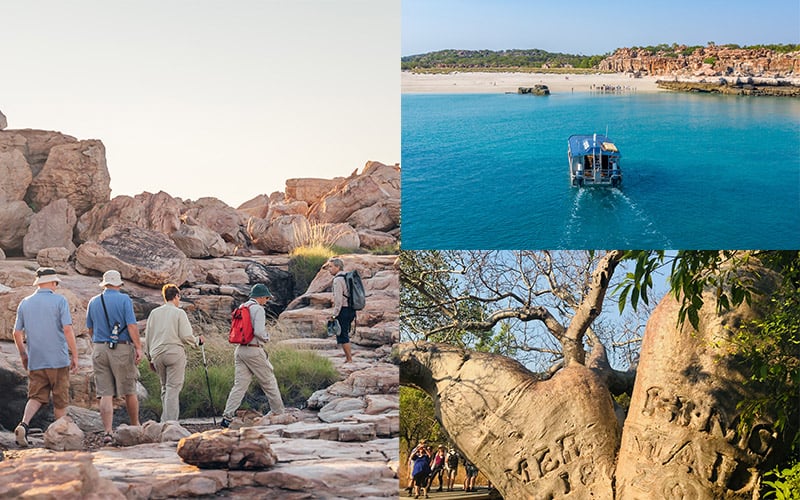
DAY 7: BIGGE ISLAND & CAREENING BAY
20 May 2021
The second largest is land in the region was our destination today. Bigge Island was named after Thomas Bigge sent out by the Colonial Office in London to investigate the affairs of the nascent colony of Sydney. He would never see this part of the world (unlike us!) but the current fashion amongst explorers and namers was to attempt to obtain favour with those in power – either for social or material advancement.
Bigge Island and the surrounding bay in many ways encapsulate the Kimberley especially with regard to the history of human contact. Here, the guests were to experience more of the Wandjina style rock art that they had had a small taste of previously. Upon climbing up the beach. the first thing they saw was an posing figure, gazing out over his country. This “father” Kaira wandjina and his retinue of smaller “children” figures maintained a serene vigil. The large figure was remarkable in that, over the centuries, people had gouged out depressions into the extremely durable sandstone, right where the figures eyes are. This was a powerful reminder of the antiquity of the culture and the devotion of its followers.
Other paintings were less spectacular visually, but told an extraordinary tale of contact between aboriginal society and others from over the waves. Outlines of boats under sail, strange men with headgear and even wandjinas smoking SE Asian clay pipes spoke eloquently to the fact that the coastal people of the Kimberley did not live in isolation, but were active participants in trade and cultural interaction.
Bigge Island will have an important role in future conservation strategy. Free of feral pests such as toads and cats it is an important refuge for wildlife that will be affected by the emergence of such pests and a reservoir of biodiversity until such time that these threats can be managed.
The other of the days destinations was a tangible link with the European heritage of the Kimberley. None other than Phillip Parker King entered this bay in 1820, with the intention careening his ship, the “Mermaid” for some much-needed repairs. She was leaking so much almost continuous pumping was required- a task that was taking its toll on the men. Upon inspection, the ship was found to have virtually no nails left. Steel ones and been used instead of copper and they had simply rusted away. King hoped fervently that replacing these nails would fix the problem (they to go all the way back to Sydney!!) but, alas when the ship was re floated and under way it was found to be still leaking.
This event, is commemorated by a large boab tree – comprised of two trunks -with the inscription HMC MERMAID 1820 incised into its trunk. Still clearly visible to this day it reminds visitors of the determination and privations faced by many of the early mariners around the shores of this uncharted but beautiful coast.
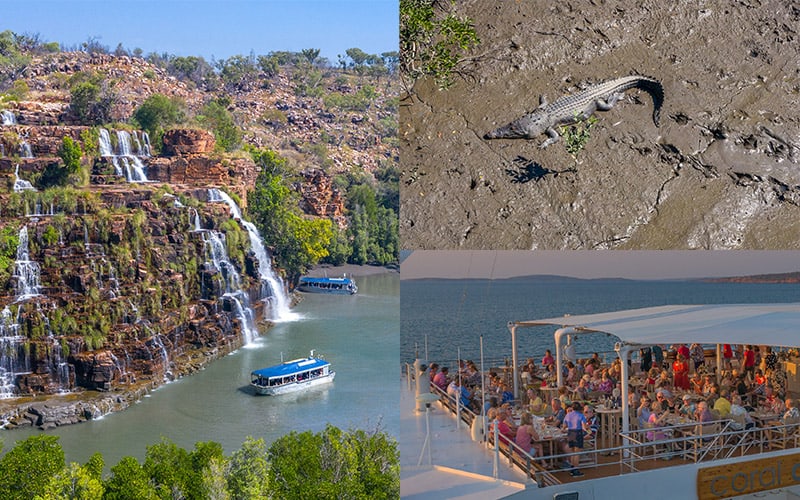
DAY 8: PRINCE REGENT RIVER, KING CASCADE & HANOVER BAY
21 May 2021
The Prince Regent River runs straight as an arrow deep into the Kimberley heartland. There are no significant bends, curves or tributaries. Normally, rivers do not behave like this.
This is no ordinary drainage. What was once an eroded rocky gorge has now been flooded by rising sea levels over 6000 years ago to form the river we now know. It is not only a physical boundary but also a cultural one – being that point at which two aboriginal language groups, Wunumbal and Worrorra, meet. The explorers are capable of travelling far up this river – to a picturesque destination with an ominous secret.
And so, we did… pausing to look at some snubfin dolphins breaking the surface close by. These are only found around Northern Australian waters and are not as “showy” as other species so any sighting is a treat for guest.
Tides being favourable, we entered a mangrove creek where several crocodiles were observed, one being a brand-new hatchling from this year basking right on the water’s edge, at no small risk to himself, given the number s of herons and Brahminy Kites we had been observing. Another species that guests were advised to look out for, the elusive and shy Chestnut Rail, also showed itself briefly as it stalked between the mangrove roots.
All of the crocs we had been seeing were quite small – 2 meters or shorter- and some of us were keen to see something bigger. Conditions were promising – a lowish tide early in the morning and sunny mudflats to bask on. Persistence paid off when we spotted a mature male of at least 4 meters at his ease on a mudflat. He lay there, unconcerned while both explorers pirouetted about, changing angles and jostling for position so as to give everyone good views and photos. If this wasn’t enough another Chestnut Rail emerged from the gloom and strode behind the crocodile in full sun – neither animal caring about the other one little bit. Aren’t these birds supposed to be rare and hard to find?
The presence of this mature crocodile was, fortunately for the guest lecturers on board, just around the corner from our destination.
King cascade is tumbling skein of water falling down a rocky terrace from the escarpment above. It flows continuously all year, although levels are reduced during the dry season. Ferns and moisture loving plants grow within the falls and either side, framed by large fig trees and the ever-present sandstone.
The explorers are capable of nosing right up to the falls with the entry ramp down, so those who wished could stand on the vessel in perfect safety and enjoy a freshwater shower. We don’t land here – this place has a secret, for in 1987 this was the scene of a fatal crocodile attack, where Ginger Meadows met her death by a crocodile of similar size to that we had just seen around the corner. A lesson for the guests. To be croc wise in croc country!
Late again!! Too much fun! A high-speed dash back to the ship was necessary to arrive in time for lunch.
One gory story per day is enough. The afternoon was much more leisurely, the ship travelling to Hanover Bay, where everyone could watch the scenery over a drink, take in a talk by one of the lecturers and work up an appetite for our famous barbeque followed by the even more famous ship’s quiz, where guests matched wits with the expedition team.
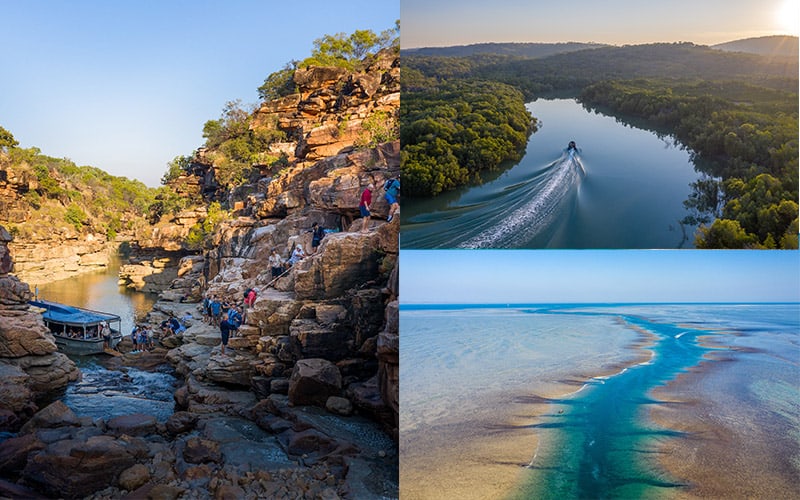
DAY 9: RED CONE CREEK & MONTGOMERY REEF
22 May 2021
Early start today. Why?? Because the tides say so. The rhythm of ship’s activities is always determined by them here. This occasion was a trip up red cone creek to Ruby Falls and the croc free waterholes above the escarpment where, at long last, everyone could have that longed for swim.
Almost everyone. The plunge pool at the bottom of the falls is easy to reach …both for us and for the crocs. The safe pools required a climb up the escarpment wall well out of croc range. Crew members had arrived early and had tied a rope from the top down to the landing area to make things a bit easier and there were lots of staff around to pull and push but it was still a bit of struggle. For some it was too much. They took another option of a cruise along the mangroves bird spotting and watching the world go by.
Those who made the climb had to walk a little further along the somewhat flatter creekside and were rewarded by the sight of a pretty little stream tumbling through the rocks, fringed with elegant pandanus trees. Both the views and the swim were restorative and refreshing-well worth getting up early for.
This afternoon’s excursion was eagerly anticipated by many. Montgomery Reef is a world-famous submerged piece of coral and algae encrusted sandstone that rises out of the sea as the massive tides fall away. Waves and steams of water runoff from the top and create spectacular waterfalls and cascade down the reef wall. Along a narrow channel sea turtle are commonly seen as well as sharks and sea snakes. Patrolling herons and other sea birds patrol the exposed reef flats, looking for food stranded by the falling water.
The tides were unfavourably small on this instance, so this meant that, while most of the reef remained under water with concurrent loss of visual spectacle, the water itself was much clearer and the turbulence much less. This enabled the explorers and zodiacs to get guests right up to the edge of the reef, where they could clearly see turtle, sharks, and many other fish cruises through the unusually clear water. So many turtles were seen that a sort of “turtle fatigue” developed. The other positive was that we were alone. No other vessels were around. Monty is a popular and must-see destination for the expedition cruise industry. Sometimes on a big tide, things can get crowded. Not this time. The solitude, the silence and the profusion of life at this remarkable place made a profound impact on the guests.
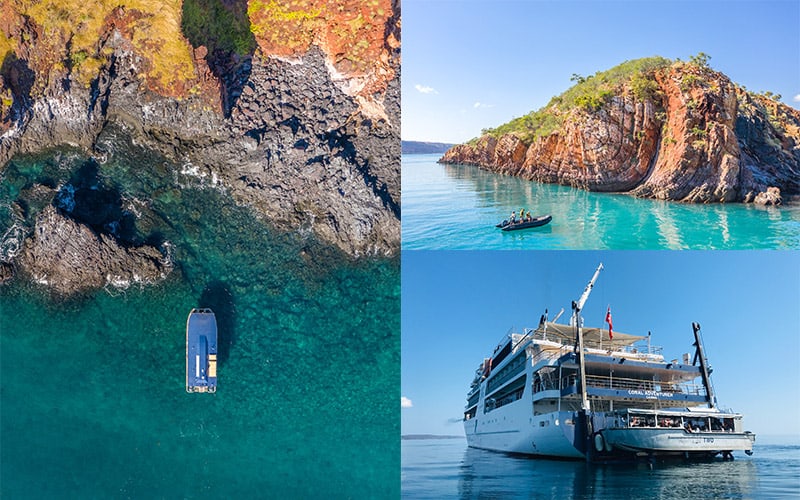
DAY 10: IRON ISLANDS, NARES POINT & KOOLAN ISLAND
23 May 2021
We have just about run out of Kimberley! A much more leisurely breakfast (8.00am!) saw the ship at anchor on a glassy sea at the Iron Islands.
As their name implies these small islands contain large amounts of very pure iron ore. In fact, the purity is such that some rocks can even be welded together with no extra refining being needed! The dark purplish colour of the ore bearing haematite contrasts with reds and greys of the sand and siltstones as well as the yellows and greens of the spinifex and trees against a cerulean sky.
Koolan island, immediately adjacent, is the site of an iron ore mine that has been operating spasmodically and with different leaseholders since the 1960s.
This valuable geological feature is a very localised one for we are now back where the voyage started – at the southern edge of the Kimberley block, where it meets the red sands of the Pindan country, close to Broome.
The explorers cruised leisurely about, taking in the formations and the glassy calm sea conditions.
Geological forces have really gone to town here. Buckles, dips, folds, strikes, synclines and anticlines all seem to contribute to a stratigraphic mish mash of from texture and colour. The outrageous folding of Nares Point, right next to the beach of the same name where the guests enjoyed their last feel of Kimberley sand between their toes is a powerful illustration of ancient forces. Other ancient sights were to be seen. Halfway up Koolan Island, away from the mine site are two caves, which show evidence having been occupied for at least 26,00 years – a nice counterpoint to the present-day activities just around the corner.
And so… just like that… back to the ship. Lunch, tea and finally Captain Miles’s farewell drinks… watching the sun set for the last time on board – all the while toasting the success of another memorable and unique cruise aboard Coral Adventurer.
DAY 11: DARWIN
24 May 2021
We said our farewells to each other and the cruise today. We disembarked in Darwin at 0800, going our separate ways. Some of us are heading home while others are continuing to travel. Many of us are hoping to keep in contact with the new friends we have made. We have very much enjoyed this trip with you, and thank you for your interest and appreciation of this spectacular part of Australia. Heartfelt thanks to all guests for their patronage and adventurous nature and best wishes for the future from everyone here at Coral Expeditions!
Article and Photo Credit: Coral Expeditions
Tradewind Voyages
It’s a sultry July evening, the water is millpond still and there’s not a cloud in the cornflower blue sky. But I’m not in tropical climes, I’m in south east England — and about to sail into the sunset on the maiden voyage of Tradewind Voyages’ Golden Horizon.
This is ‘staycation’ cruising, and with specially composed classical music setting the scene, the evening has a real sense of drama and anticipation.
Sail aways are always a holiday highlight — the perfect excuse to come together with fellow passengers and toast your departure with a celebratory glass in hand. But on Tradewind Voyages’ traditional sailing ship Golden Horizon, sail aways are like no other you may have previously experienced.
The music is stirring and with the setting sun framing our pictures, it’s an idyllic end to the day as we leave Dover and those famous white cliffs behind.
But our attention is soon diverted as the majestic sails on this, the world’s biggest square rigged sailing ship, gently start to unfurl, giving the vessel the power to forge ahead on its course.
It’s a magical, moving and captivating moment and, I guarantee, should you ever sail on this elegant ship, one you won’t forget in a hurry.
Built as a near replica of the traditional sailing vessel France II (the second largest commercial sailing ship ever built), Golden Horizon has tall ship elegance in spades. With five towering masts and the largest amount of sail above water — 6,347 metres to be exact — if you like the idea of being at one with the ocean, this could be your perfect cruise match.
Mother Nature is quite literally the ship’s compass: with sustainability as a focus, the aim is to sail without using engines as much as possible under the right wind and currents — around 70 per cent each season.
It’s rather mind-blowing to think that the ship can go faster under sail than when powered by its engines.
With a global pandemic still in the air, embarkation takes a little longer these days: a lateral flow Covid test at the port determines whether I get to sail or not. Happily, it’s negative, so I’m free to board and celebrate with a glass of champagne at the pool bar — my first on a ship in 18 months.
There are no waterslides or casinos to be found on Tradewind Voyages’ 272-passenger Golden Horizon: this is an intimate, authentic sailing vessel with a boutique feel, and which captures the romance of maritime traditions from years gone by.
Many of the guests are sailing enthusiasts and fascinated by the ship itself. These adventurous sailors also relish true sailing conditions and aren’t too bothered that there are no stabilisers on the ship (but those without reliable sea legs take note).
The interior is elegant and traditional with retro accents: nautical knot carpeting, glossy teak wood furnishings, gleaming brass and classical maritime artworks. Even the dimly lit gym looks like a private member’s club. It’s also worth noting, however, that there’s no lift on board.
There are 140 cabins in total, ranging from porthole cabins to balconies, plus four blow-the-budget suites with fireplaces and butler service. All have sea views.
My porthole cabin on the gallery deck is very homely and features a large double bed with huge pillows, a gold and marble bathroom with Noble Isle toiletries and an excellent shower, robes and slippers, complimentary mineral water, tea and coffee making facilities, WiFi, USB charging points and a TV with free movies for those rainy days.
Along with a reduced number of guests on board due to Covid protocols, you’ll find the line’s ‘Good Habit Policy’ on the TV. Sanitising stations are stationed throughout the ship, and you are asked to wear a face covering in public areas and wash your hands regularly.
There’s no doubt that this is a real head-turner of a ship; everywhere she sails she attracts attention.
My cruise calls at Cowes and Plymouth — Golden Horizon is at tender in both locations, which gives a steady stream of yachts the perfect opportunity for a closer look.
Our fascinating two-hour Plymouth walking tour with an excellent local guide took us to the bustling Barbican district, followed by the Citadel and the Hoe, where Drake was famously playing bowls when he received the news of the invading Armada.
But this ship is all about exploration and guided by the sun, prevailing wind and currents, Golden Horizon will soon head south to off-the-beaten-track locations such as Croatia’s Kornati Islands — a national park archipelago comprising 140 uninhabited islands and reefs.
Onboard, you’ll probably want to spend as much time as possible out on the split level top deck: from the wooden decking that stretches as far as the eye can see, to the authentic ropes and winches operated by the hardworking deck crew, the popular pool bar and the three saltwater pools, it’s a great place to be.
Blessed with sunshine for the majority of my five-night voyage, I get quite used to propping up the bar at sunset, and enjoy strolling under the unfurled, illuminated sails of an evening.
Unlike most other ships, there’s an open bridge policy too, so you’re free to talk to Captain Szalek and his officers as long as they are not undertaking navigational manoeuvres.
Service throughout the ship is ‘friendly but not overfamiliar’ — dress is casual and comfortable by day and smart casual in the evenings.
A typical day might include a morning yoga flow up on the Bridge deck followed by a healthy oatmeal ‘Soul Bowl’ and fresh fruit for breakfast, then perhaps an organised shore excursion (in a bubble for now and charged for), with afternoons reserved for deck games, dips in the pool and, weather permitting, soaking up some rays.
Golden Horizon is a great choice for active types, as there is a superb watersports marina located at the stern of the ship.
Guests’ gateway to the ocean, complimentary activities on offer off the hydraulic platform include stand-up paddle boarding, snorkelling, kayaking, sea bobs (for an additional charge) and windsurfing.
You can also swim (subject to availability and conditions), and there are wetsuits on hand should you need them. Another unique feature is the 4.35 metre saltwater dive pool where you can enjoy a taster scuba session or begin PADI accreditation.
Meanwhile, the good-sized spa uses marine-based Thalgo products and offers facials, body wraps, pedicures and a hydrotherapy bath. While enjoying this zen space, it’s well worth taking advantage of the free-to-all facilities including sauna, Hammam and snow room.
Breakfast, lunch and dinner are taken in the impressive two-deck main dining room — a real centrepiece of the ship with curving (and quite steep in places) staircases and a glass skylight which lets light flood in: look again and you’ll see that this is actually the bottom of the main pool.
With table service only, it’s elegant without being too formal, and there are no set dining times.
Image Credit – Rebecca Barnes @ The JC
When the weather’s fine, you can also have lunch and dinner al fresco at the Horizon Bar & Grill which doubles up as an entertainment venue. In the unlikely event of mid-afternoon hunger pangs, head to the piano lounge for canapés and cakes.
There is an ‘Eat Well, Live Well’ ethos and everything is simply prepared, classic and healthy: fresh, seasonal produce is served when possible. There’s a good choice of options for vegans and vegetarians, while kosher diets can also be catered for with prior arrangement.
Appetisers such as vegetable spring rolls and salmon gravadlax, followed by sesame crusted tuna steak and butternut and chickpea korma (a personal highlight) are typical dishes served in the evening; there’s a number of ‘always available’ options, too.
While the menu isn’t short of indulgent treats, you’ll also find healthy options such as a fresh fruit plate as alternatives to a rich dessert if you fancy.
Then after dinner, dance the night away to the resident musical duo in the Horizon bar, although many guests gravitate upstairs to the piano bar to partake in a quiz, followed by a nightcap.
While I would never have considered a UK cruise before, I now wouldn’t hesitate to recommend a no-fly ocean adventure, and appreciate my homeland even more.
Although that said, with the wind in the sails and the sun shining on a blue sea, a Caribbean sailing on Golden Horizon would definitely appeal too.
Article and photo credits: Rebecca Barnes @ The Jewish Chronicle (thejc.com)
First published online 15 August 2021
Ocean Medallion
Princess Cruises Innovative Technology

The Ocean Medallion is a wearable device that is being used in place of the cruise card, on some of Princess’s ships, Ruby Princess being one of them to start, with a view to this innovative technology being rolled out on all of their ships.
It is approximately the size of a 10 cent piece and is worn in a number of accessories, including pendants, bracelets, sports bands and clips. This waterproof device is interactive for guests and staff alike.
The medallion is given to you at check-in, the same as a cruise card. You will need to download the MedallionClass App through your app store on your phone before sailing. Once downloaded, follow the instructions to create your Ocean Profile. The features on the app that I enjoyed the most was firstly the ease of access to my stateroom. The medallion recognises you as you approach your cabin and automatically opens your cabin door.
The WiFi connectivity called MedallionNet is reliable and incredibly fast, often better than land-like connectivity. Allows you to stream shows, movies and sport easily and anywhere on the ship. A bonus with this offering is that you can make voice and video calls too. A good thing with this also is that the bandwidth doesn’t vary depending on what plan you purchase, it’s all great. You can pre-purchase this package through your cruise personaliser or get it once onboard.
Another wonderful feature was being able to locate my friends on the ship. You are able to see their location on your phone and even message them through the app. I was also able to order a drink from my sunbed while lying around the pool. The waiter then brought the drink to me, very spoilt! Another great feature of the Medallion for staff is that they are able to recognise when you have left your cabin, making it easier for them to service your room. They can then be more efficient with their time and don’t have to constantly interrupt guests to see if they can make up your room.
The medallion is a great new concept to make customers onboard experience smoother sailing, pardon the pun. While I didn’t use all of its features, the ones I did were great!

European Cruising Christmas
Christmas will be here again before you know it so now’s the time to plan your next festive escape
In that spirit, a ‘part-time’ Christmas scrooge from Australia rediscovers the joy of the season on a Yuletide Markets cruise with Riviera Travel from Hungary to Slovakia and Austria.
By Andrew Mevissen
Don’t get me wrong, I love Christmas. But like the Olympics, I just think Christmas should be celebrated every four years. There’s so much rushing, stressing and preparing that the storybook magic of the season dwindles – for me anyway – and it all comes around so quickly each year.
But last Christmas this part-time Scrooge rediscovered the joy of the season when I boarded one of Riviera Travel’s Yuletide Markets cruises in Europe. How could I not be swept up in festive traditions and breathless anticipation when I’m in a riverside town’s medieval square festooned with twinkling lights and colourful decorations and brimming with jolly carollers and enchanting timber stalls selling cuckoo clocks, wooden toys, artisan gifts and every type of Christmas treat and trinket you could imagine. Ice skaters glide around glittering fir trees and the sweet scents of cinnamon, honey cookies, mulled wine and roasted chestnuts fill the frosty air.
It feels like I’ve been embedded in a Christmas card. In under 24 hours I’ve been transported from a sizzling Sydney summer in Australia to a winter wonderland in Europe, celebrating our happiest season of all.

‘Our festive cruise had begun’
Our six-day cruise in mid-December started in Budapest when we boarded Riviera Travel’s five-star river ship, MS Thomas Hardy, a modern, gleaming, elegant vessel more akin to a floating, boutique hotel. An impressive line of staff welcomed us onboard in the sparkling, marble-floored lobby. Complimentary bon voyage drinks were offered, our baggage was delivered to cabins in a flash and our festive cruise had begun.
Named after the famous British writer, MS Thomas Hardy is a beautiful and spacious ship boasting an ambience that is stylishly casual and charmingly mellow. There are rich hardwoods, gleaming brass, polished copper, expansive glass and intricate wrought iron – all creating a harmonious atmosphere of understated elegance and all designed to make guests as relaxed as the flow of the Danube. With only 169 passengers onboard, the friendly and personable crew quickly remember your face and name and you get to know your fellow passengers quickly as well.
As soon as you board the ship you feel the yuletide spirit, thanks to colourful Christmas trees and decorations, traditional Christmas delicacies on the restaurant’s menus, nostalgic Christmas movies on your cabin TV and favourite carols performed by the lounge pianist. But the best part is we don’t need to cook, wash dishes or clean – a perfect Christmas celebration in my book!

‘Joyfully mesmerising’
Our lovely stateroom sported a French balcony – a panoramic, floor-to-ceiling sliding glass door that, when opened, turns our suite into an alfresco sunroom. All cabins enjoy a river view and it was joyfully mesmerising to lie on our big, comfy bed and watch the gentle pastoral landscapes floating by, listening to the gentle, lapping water through our open glass door. Our stateroom offered a sitting area, ample space under the bed for luggage, flat screen TV with a bridge camera channel, individually controlled air-conditioning, phone, hairdryer, handy USB ports for phone charging, bathrobes/slippers and tea and coffee-making facilities including a small coffee pod machine – a nice and unusual touch. The marble bathroom boasted Crabtree & Evelyn toiletries. There’s an evening turn-down service too with chocolates on the pillows.
Flanked by panoramic windows, the tables in the main restaurant were beautifully laid out with crisp linen. A second, smaller bistro at the rear of the ship offered an alternative, casual dining venue overlooking the wake and back along the river. And unlike specialty restaurants on ocean ships, the bistro was complimentary. But like on all ships, there seems to be an unwritten rule in seafaring law that all passengers are never allowed to have more than a few hours between meals. That was certainly the case aboard Thomas Hardy where the tireless chefs were eager to please our palates around the clock. A highlight was a festive, eight-course degustation dinner – a delectable and veritable feast featuring seared prawns, rillette of duck, winter bisque, pan-fried halibut and rum balls.

The River Journey
Our five-night journey aboard Thomas Hardy took us along the storied Danube River from the gilded palaces of Budapest to the romantic old town of Bratislava in Slovakia and the baroque splendour of Vienna. In each port there was a free excursion which typically included a guided coach and walking tour for half a day or so, leaving the rest of the day to explore on your own – including the stunning Christmas markets of each port. My wife and I were like excited little children, following mazes of cobblestoned streets leading to town squares soaked in sensory-filling Christmas magic. We sampled local delicacies and bought Christmas decorations back home for our grown-up children.
I thought Australia showcased Christmas pretty well in the decoration department but Europe wins the prize hands down, with spectacular displays everywhere – and I mean everywhere – especially in front of the Vienna Town Hall where one of Europe’s biggest Yuletide markets unfolds every season. After all, the traditions which we now love about Christmas originated in Europe so it was an eye-opening, bucket list experience for a Down Under summer worshipper like me to finally experience a winter Christmas.

Immersing in the local culture
But as wonderful as the Christmas celebrations were, my wife and I always like to steal away from the crowds and join locals in places that help us authentically experience the cultural fabric of a destination. In beautiful Budapest we immersed ourselves in the huge, steamy, outdoor thermal pools of the historic Szechenyi Baths, wandered the cavernous halls of the giant Central Market Hall, savoured hearty goulash soup in the glorious surrounds of the Central Café for lunch and stood in awe at the magnificent Parliament Building, brilliantly lit at night.
In picture-book-lovely Bratislava, we borrowed two of our ship’s complimentary bicycles and cycled along the river and through backstreets, stopping for hot chocolate. And in magnificent, wintry Vienna, we picked the cosiest, warmest café we could find to indulge in traditional apple strudel and Vienna coffee! In every place, we walked, wandered, watched and wrapped up during the short, cold days, returning always to the luxury and warmth of the Thomas Hardy at the end of the day. And how delightful, before leaving Vienna, for the passengers to be serenaded by an Austrian string quartet which came aboard the ship to perform a spine-tingling concert featuring composers who loved Vienna, such as Mozart, Bach and Strauss.

Our favourite experience
But as appealing as advent markets and grand, historic cities were, our absolute best memory of our short river sojourn was soaking in the ship’s top-deck, open-air plunge pool, heated to toasty jacuzzi temperatures in winter. We were in there at dawn and at dusk and after dinner under the stars, coffee or wine in hand, soaking in the majestic splendours of Europe all around us. Just bliss! It was, indeed, beginning to look a lot like Christmas.
Returning home to a hot summer in Australia, just three days before Christmas, I was now, finally, in the mood to celebrate the joy of the season!

To find out more about Riviera Travel’s Yuletide Market Cruises in Europe, call us at Cruise Express on 1300 766 537 or visit www.cruiseexpress.com.au
Nature’s Ultimate Playground
The Sub-Antarctic region holds incredibly unchartered abundance and diversity
While most of us are very familiar (and some even luckier to have been) to the Antarctic, the Sub-Antarctic is a little less familiar and far less touristed. Located in the southern hemisphere, immediately north of the Antarctic region, the Sub-Antarctic includes many islands in the very southern parts of the Indian Ocean, Atlantic Ocean and the Pacific Ocean.
The Sub-Antarctic Islands of New Zealand and Australia are the ultimate in eco-tourism and have UNESCO World Heritage status, with some of the best-preserved and protected nature reserves in the world! These islands are so pristine and remote, and enjoy some of the most abundant and often endemic wildlife, with rare plants, birds and other animals. Fortunately, the isolation and harsh weather of the region are partially responsible for having kept tourists at bay and the New Zealand Government strictly controls shore visits.
Visitors are treated so sightings of fur, leopard and elephant seals, along with giant petrels, Auckland shags and Campbell Island teals, one of the rarest flightless birds in the world. 10 of the world’s 24 species of albatross breed in these islands, with five being endemic to the region. Campbell Island has six species, including the largest breeding population of southern royal albatrosses, the largest albatross in the world.
10 species of penguins inhabit the islands, two of them endemic (the Snares crested and erect-crested penguins), as well as king, royal and yellow-eyed penguins. Not uncommon are sightings of southern right, humpback and sperm whales, particularly around and in the harbours of Campbell Island.

The history of this region is fascinating and disturbing. Over the centuries, particularly in the 1800s, mankind wreaked havoc on the region, destroying much in its wake including a great deal of seal and whale slaughtering, even sea lions were hunted to extinction on the mainland (they are still critically endangered and confined mostly to the Sub-Antarctic).
Not surprisingly, there were a significant amount of shipwrecks in the area in the 1800s. What seemed like a good idea at the time, was to provide provisions for survivors, so ‘castaway’ depots were created on land including Campbell Island. As technological advances in shipping meant the different trade routes by steam were embraced, these depots were abandoned. Unbelievably, these abandoned pigs, rabbits, goats, and rats annihilated vegetation, feral cats wiped out many native birds and sheep even developed self-dropping fleeces!
The introduction of invasive species including rats, rabbits, feral cats and farm animals was also catastrophic. While it is an ongoing issue for many of the islands, there is slow progress and in some areas, painstaking eradication programs have been successful, enabling many islands to flourish again.

Fortunately, a great deal of work has been done in preservation and conservation for many decades and for those preferring to travel to an uncrowded, immersive and unique destination, the Sub-Antarctic is the ultimate destination.

To find out more about how you can visit this remarkable destination call us on 1300 766 537 or email info@cruiseexpress.com.au
















